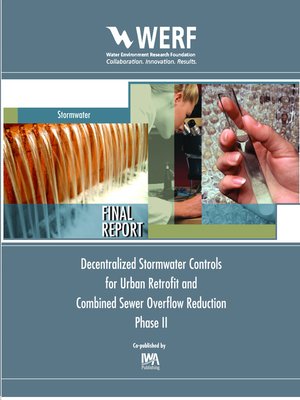Decentralized Stormwater Controls for Urban Retrofit and Combined Sewer Overflow Reduction, Phase 2
ebook ∣ WERF Research Report
By Neil Weinstein

Sign up to save your library
With an OverDrive account, you can save your favorite libraries for at-a-glance information about availability. Find out more about OverDrive accounts.
Find this title in Libby, the library reading app by OverDrive.



Search for a digital library with this title
Title found at these libraries:
| Library Name | Distance |
|---|---|
| Loading... |
Phase 1 of this project demonstrated the technical feasibility of using decentralized stormwater controls in urban areas for retrofits and controlling combined sewer overflows. This technical feasibility was illustrated by a number of early adopters using decentralized controls to complement their existing municipal stormwater and wastewater infrastructure. However, institutional and programmatic issues required further study to broaden the use of a distributed, decentralized stormwater approach.
This research evaluates implementation strategies for incorporating decentralized controls into an infrastructure management system. The distributed nature and multiple environmental benefits of decentralized controls necessitate an integrated and inter-departmental management approach. The results of this research identify various implementation strategies for incorporating decentralized controls into urban infrastructure management programs. Case studies and programmatic and regulatory examples detail alternatives to expedite the adoption of decentralized controls. Managing infrastructure by limiting demand is explored in the context of distributed controls. In addition, an evaluation of economic methods appropriate for assessing environmental costs and benefits is included to more fully capture the financial consideration of decentralized controls. Guidance for modeling decentralized controls with commonly used stormwater models is also provided.
This research evaluates implementation strategies for incorporating decentralized controls into an infrastructure management system. The distributed nature and multiple environmental benefits of decentralized controls necessitate an integrated and inter-departmental management approach. The results of this research identify various implementation strategies for incorporating decentralized controls into urban infrastructure management programs. Case studies and programmatic and regulatory examples detail alternatives to expedite the adoption of decentralized controls. Managing infrastructure by limiting demand is explored in the context of distributed controls. In addition, an evaluation of economic methods appropriate for assessing environmental costs and benefits is included to more fully capture the financial consideration of decentralized controls. Guidance for modeling decentralized controls with commonly used stormwater models is also provided.







